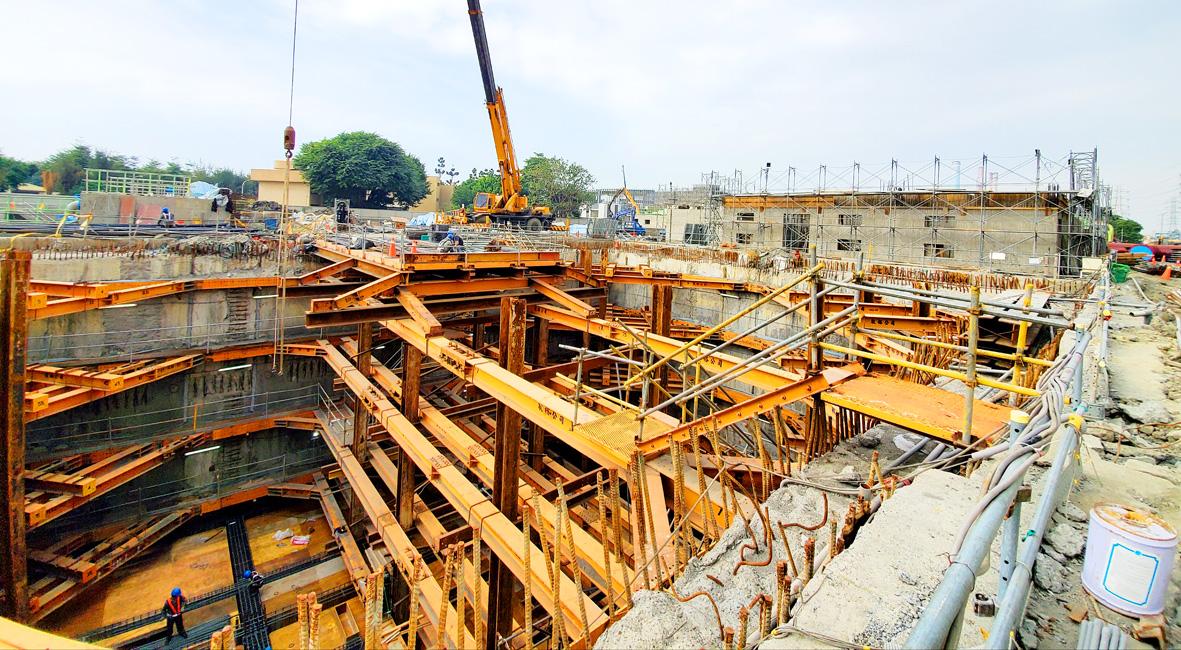The official manufacturing purchasing managers’ index (PMI) last month fell to 63.2, slowing from an unprecedented high a month earlier, as the Lunar New Year holiday cut the number of working days, while firms displayed the strongest business sentiment on record, the Chunghua Institution for Economic Research (CIER, 中華經濟研究院) said yesterday.
All manufacturing sectors except textile and food suppliers reported business upswings last month from a year earlier, although the Lunar New Year holiday eliminated one week, which explains why the economic barometer stayed in the expansion zone, but shed 1.9 points, the Taipei-based think tank said.
PMI data aim to capture the health of the manufacturing industry, with scores lower than 50 indicating contraction and values above the neutral threshold signaling expansion.

Photo: Chen Wen-chan, Taipei Times
“Holiday disruptions accounted for the month-on-month retreat, which is harmless, as firms expressed clear order visibility for the coming six months,” CIER president Chang Chuang-chang (張傳章) told a media briefing.
Expectations of a global economic recovery have led businesses around the world to rebuild inventory, ramping up production at their local suppliers, Chang said, adding that the trend would become more evident as more people receive COVID-19 vaccines.
The reading on the six-month business outlook added 3.2 points to a record 73.3, as orders swelled across all sectors, Chang said.
For last month, the sub-index on new work stood at 65.6, comfortably in the positive territory, and so was the industrial output measure, at 63.9, the CIER survey showed.
Hiring activity hovered at a similar level of 58, or 0.5 points lower from one month earlier.
The sub-index for delivery time held steady at 73.3, as container shortages and shipping delays deteriorated, it said.
Customers’ inventory level was 44.5, 1.3 points lower from one month earlier.
The measure on raw material prices surged to 87.8, the highest since the launch of the survey in July 2012, as recovery expectations pushed up demand, Chang said, adding that a global container shortage and earlier snow storms in the US made things worse.
Strong order visibility drove some firms to rearrange shipment schedules by first meeting demand from customers who offered higher prices or placed larger orders, CIER researcher Chen Shin-hui (陳馨蕙) said.
Firms are more eager to replenish inventory and less concerned about material costs, compared with the previous quarter, Chen said.
Purchasing activity among non-manufacturing firms last month showed a similar pattern of losing some steam with a reading of 52.1, 2.9 points lower than in January, CIER said.
Unfavorable holiday effects were poignant for shipping and logistics service providers and insurance companies, the institute said.
Service-focused firms are generally upbeat about business moving forward, except restaurants and hotels, it said.

TECH BOOST: New TSMC wafer fabs in Arizona are to dramatically improve US advanced chip production, a report by market research firm TrendForce said With Taiwan Semiconductor Manufacturing Co (TSMC, 台積電) pouring large funds into Arizona, the US is expected to see an improvement in its status to become the second-largest maker of advanced semiconductors in 2027, Taipei-based market researcher TrendForce Corp (集邦科技) said in a report last week. TrendForce estimates the US would account for a 21 percent share in the global advanced integrated circuit (IC) production market by 2027, sharply up from the current 9 percent, as TSMC is investing US$65 billion to build three wafer fabs in Arizona, the report said. TrendForce defined the advanced chipmaking processes as the 7-nanometer process or more

China’s Huawei Technologies Co (華為) plans to start mass-producing its most advanced artificial intelligence (AI) chip in the first quarter of next year, even as it struggles to make enough chips due to US restrictions, two people familiar with the matter said. The telecoms conglomerate has sent samples of the Ascend 910C — its newest chip, meant to rival those made by US chipmaker Nvidia Corp — to some technology firms and started taking orders, the sources told Reuters. The 910C is being made by top Chinese contract chipmaker Semiconductor Manufacturing International Corp (SMIC, 中芯) on its N+2 process, but a lack

NVIDIA PLATFORM: Hon Hai’s Mexican facility is to begin production early next year and a Taiwan site is to enter production next month, Nvidia wrote on its blog Hon Hai Precision Industry Co (鴻海精密), the world’s biggest electronics manufacturer, yesterday said it is expanding production capacity of artificial intelligence (AI) servers based on Nvidia Corp’s Blackwell chips in Taiwan, the US and Mexico to cope with rising demand. Hon Hai’s new AI-enabled factories are to use Nvidia’s Omnivores platform to create 3D digital twins to plan and simulate automated production lines at a factory in Hsinchu, the company said in a statement. Nvidia’s Omnivores platform is for developing industrial AI simulation applications and helps bring facilities online faster. Hon Hai’s Mexican facility is to begin production early next year and the

Who would not want a social media audience that grows without new content? During the three years she paused production of her short do-it-yourself (DIY) farmer’s lifestyle videos, Chinese vlogger Li Ziqi (李子柒), 34, has seen her YouTube subscribers increase to 20.2 million from about 14 million. While YouTube is banned in China, her fan base there — although not the size of YouTube’s MrBeast, who has 330 million subscribers — is close to 100 million across the country’s social media platforms Douyin (抖音), Sina Weibo (新浪微博) and Xiaohongshu (小紅書). When Li finally released new videos last week — ending what has